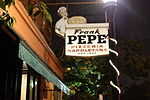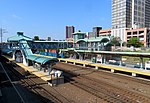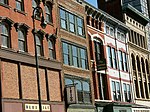Sally's Apizza
1938 establishments in ConnecticutBuildings and structures in New Haven, ConnecticutEconomy of New Haven, ConnecticutItalian-American culture in ConnecticutPizzerias in the United States ... and 4 more
Restaurants established in 1938Restaurants in ConnecticutTourist attractions in New Haven, ConnecticutUnited States restaurant stubs

Sally's Apizza is a pizzeria in the Wooster Square neighborhood of New Haven, Connecticut. Sally's Apizza also has locations in Stamford, Connecticut and Fairfield, Connecticut.
Excerpt from the Wikipedia article Sally's Apizza (License: CC BY-SA 3.0, Authors, Images).Sally's Apizza
Wooster Street, New Haven
Geographical coordinates (GPS) Address Nearby Places Show on map
Geographical coordinates (GPS)
| Latitude | Longitude |
|---|---|
| N 41.303043 ° | E -72.919942 ° |
Address
Wooster Street 235
06511 New Haven
Connecticut, United States
Open on Google Maps









